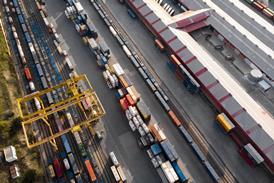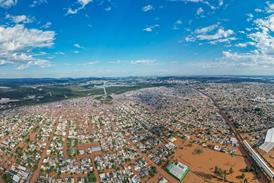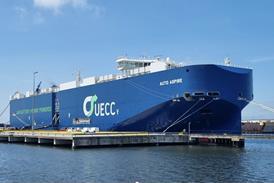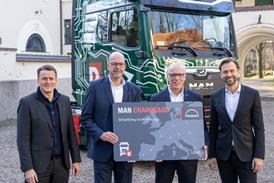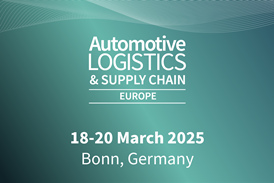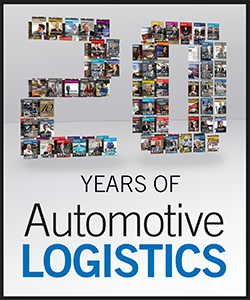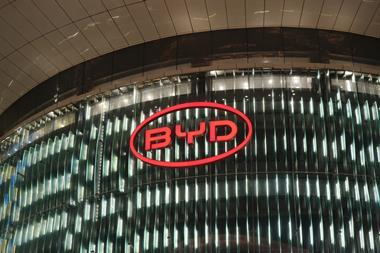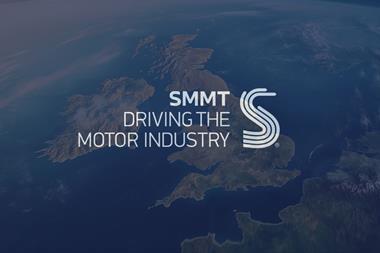This article is one of a series of pieces celebrating Automotive Logistics’ 20th anniversary issue that together take an extended look at the way top executives feel automotive production and logistics have changed in the last two decades – and where they see them heading in the future.
 Audi Dr Michael Hauf, head of brand logistics, leads the carmaker’s cross-plant logistics across inbound, outbound, programme planning, pre-series and international logistics. He joined Audi in 1984 in logistics planning, later leading central logistics planning from Ingolstadt. Twenty years ago, he took over factory planning for Audi ahead of a period of international plant expansion, as well as work on a number of new building projects. He has held his current post since 2011.
Audi Dr Michael Hauf, head of brand logistics, leads the carmaker’s cross-plant logistics across inbound, outbound, programme planning, pre-series and international logistics. He joined Audi in 1984 in logistics planning, later leading central logistics planning from Ingolstadt. Twenty years ago, he took over factory planning for Audi ahead of a period of international plant expansion, as well as work on a number of new building projects. He has held his current post since 2011. Audi Johannes Marschall, head of plant logistics Neckarsulm, is responsible for material flow, packaging and in-plant logistics at Audi’s most complex plant in terms of parts and model variety. He started at Audi in 1995 in logistics planning for both German plants and new foreign facilities, later leading production planning for bodyshop. For 10 years until 2016, he led logistics for the Ingolstadt plant before taking over Neckarsulm.
Audi Johannes Marschall, head of plant logistics Neckarsulm, is responsible for material flow, packaging and in-plant logistics at Audi’s most complex plant in terms of parts and model variety. He started at Audi in 1995 in logistics planning for both German plants and new foreign facilities, later leading production planning for bodyshop. For 10 years until 2016, he led logistics for the Ingolstadt plant before taking over Neckarsulm.
 Audi Simon Motter, head of plant logistics Ingolstadt, is responsible for conception, operational logistics and logistics planning at Audi’s largest global plant. He joined the OEM in 1999 as a logistics planner, before working at plants in Spain and Hungary and joining brand logistics in 2009, where he was responsible for planning Audi’s new car plant in Györ, Hungary and later Mexico. He took over plant logistics in Ingolstadt last year. In 1997, he was studying material flow and logistics in Berlin under renowned academic Dr Helmut Baumgarten.
Audi Simon Motter, head of plant logistics Ingolstadt, is responsible for conception, operational logistics and logistics planning at Audi’s largest global plant. He joined the OEM in 1999 as a logistics planner, before working at plants in Spain and Hungary and joining brand logistics in 2009, where he was responsible for planning Audi’s new car plant in Györ, Hungary and later Mexico. He took over plant logistics in Ingolstadt last year. In 1997, he was studying material flow and logistics in Berlin under renowned academic Dr Helmut Baumgarten.
 China Federation of Logistics and Purchasing (CFLP) Ma Zengrong is vice-chairman, and head of the China Automotive Logistics Association (CALA). He has been with CFLP since it was established in 2002 with support from the Chinese government. He went on to help establish the CALA branch for automotive in 2004. He would later be appointed deputy general secretary and was awarded his current position in 2014. Twenty years ago, he admits, he had never even heard of the word logistics – he learned it in 2000.
China Federation of Logistics and Purchasing (CFLP) Ma Zengrong is vice-chairman, and head of the China Automotive Logistics Association (CALA). He has been with CFLP since it was established in 2002 with support from the Chinese government. He went on to help establish the CALA branch for automotive in 2004. He would later be appointed deputy general secretary and was awarded his current position in 2014. Twenty years ago, he admits, he had never even heard of the word logistics – he learned it in 2000.
 Ford Joe Hinrichs is executive vice-president and president of global operations, with responsibilities that include product development, manufacturing and purchasing. After working for GM and in consulting, he joined Ford in 2000 and has held roles that have included leading global material planning and logistics (MP&L), manufacturing, and later heading the Asia Pacific and Americas regions, before starting his current post this year. Two decades ago, he led the operations of GM’s Romulus engine plant to launch new V8 engines.
Ford Joe Hinrichs is executive vice-president and president of global operations, with responsibilities that include product development, manufacturing and purchasing. After working for GM and in consulting, he joined Ford in 2000 and has held roles that have included leading global material planning and logistics (MP&L), manufacturing, and later heading the Asia Pacific and Americas regions, before starting his current post this year. Two decades ago, he led the operations of GM’s Romulus engine plant to launch new V8 engines.
 Ford Dirk Willmann, director of MP&L for Europe, heads logistics and production planning across Europe, as well as leading processes for the Middle East and Africa, and joint ventures in Russia and Turkey. He joined Ford in 1992 in manufacturing quality, holding various MP&L roles from 2000 before starting in his current post in 2015. Twenty years ago, he was on assignment for a quality project for two US plants. (See our recent extended interview with Willmann.)
Ford Dirk Willmann, director of MP&L for Europe, heads logistics and production planning across Europe, as well as leading processes for the Middle East and Africa, and joint ventures in Russia and Turkey. He joined Ford in 1992 in manufacturing quality, holding various MP&L roles from 2000 before starting in his current post in 2015. Twenty years ago, he was on assignment for a quality project for two US plants. (See our recent extended interview with Willmann.)
 General Motors Edgard Pezzo, executive director of global logistics and containerisation, has been with GM for more than 30 years. He has held a variety of roles in supply chain and purchasing, notably in his native Brazil, including as vice-president of global purchasing and supply chain for South America until 2013, when he took up his current role. Twenty years ago, Pezzo was purchasing manager for GM Brazil.
General Motors Edgard Pezzo, executive director of global logistics and containerisation, has been with GM for more than 30 years. He has held a variety of roles in supply chain and purchasing, notably in his native Brazil, including as vice-president of global purchasing and supply chain for South America until 2013, when he took up his current role. Twenty years ago, Pezzo was purchasing manager for GM Brazil.
 Honda North America Dana McBrien, associate chief advisor, leads the carmaker’s inbound logistics for US plants with key roles in Mexico and Canada. He joined Honda in 1984 in finance and purchasing, and has been instrumental in forming and leading a central logistics function starting in 2002, which has since grown to encompass all US plants, international logistics, links across North America and wider supply chain functions. In 1997, he had just finished work with a team implementing an MRP system for Honda and was working on other new supply chain systems.
Honda North America Dana McBrien, associate chief advisor, leads the carmaker’s inbound logistics for US plants with key roles in Mexico and Canada. He joined Honda in 1984 in finance and purchasing, and has been instrumental in forming and leading a central logistics function starting in 2002, which has since grown to encompass all US plants, international logistics, links across North America and wider supply chain functions. In 1997, he had just finished work with a team implementing an MRP system for Honda and was working on other new supply chain systems.
 Kia Motors Manufacturing Georgia Kevin Kinsey, head of procurement department, is responsible for material purchasing, supplier quality and logistics activities for Kia’s US plant, a role he has held since joining Kia in 2011. Before then, he worked in purchasing, supply chain and production roles at Honda, Panasonic and Invision. In 1997, he had just returned to the US after a two-year assignment in Japan for Honda as new model development liaison for US plants, gaining cultural insight he says is still valuable in working with Kia to this day.
Kia Motors Manufacturing Georgia Kevin Kinsey, head of procurement department, is responsible for material purchasing, supplier quality and logistics activities for Kia’s US plant, a role he has held since joining Kia in 2011. Before then, he worked in purchasing, supply chain and production roles at Honda, Panasonic and Invision. In 1997, he had just returned to the US after a two-year assignment in Japan for Honda as new model development liaison for US plants, gaining cultural insight he says is still valuable in working with Kia to this day.
 Magna Steyr Michael Druml, director of purchasing and logistics, leads on purchasing, supplier quality, logistics, materials handling, customs and distribution. His time with the company goes back to 1992 when he worked in inventory and production control at Eurostar, a joint venture at the time between Chrysler and then-Steyr Daimler Puch in Graz, Austria. After Magna took over the company and created Magna Steyr in 2002, he worked his way up to lead global supply chain. About 20 years ago, he was part of the post-merger team for DaimlerChrysler.
Magna Steyr Michael Druml, director of purchasing and logistics, leads on purchasing, supplier quality, logistics, materials handling, customs and distribution. His time with the company goes back to 1992 when he worked in inventory and production control at Eurostar, a joint venture at the time between Chrysler and then-Steyr Daimler Puch in Graz, Austria. After Magna took over the company and created Magna Steyr in 2002, he worked his way up to lead global supply chain. About 20 years ago, he was part of the post-merger team for DaimlerChrysler.
 Mercedes-Benz Alexander Koesling, head of supply chain management, leads a central organisation that includes planning and controlling worldwide production, inbound logistics and in-plant logistics for vehicle and powertrain plants, and global vehicle transport. He started his career with then Daimler-Benz in 1988 in corporate planning and controlling and has held various roles in strategy, operations, new vehicle development, product cost engineering and module strategies for passenger cars. He took up his current post in 2014 as the carmaker restructured its logistics.
Mercedes-Benz Alexander Koesling, head of supply chain management, leads a central organisation that includes planning and controlling worldwide production, inbound logistics and in-plant logistics for vehicle and powertrain plants, and global vehicle transport. He started his career with then Daimler-Benz in 1988 in corporate planning and controlling and has held various roles in strategy, operations, new vehicle development, product cost engineering and module strategies for passenger cars. He took up his current post in 2014 as the carmaker restructured its logistics.
 VW Group Thomas Zernechel, head of Volkswagen group logistics, is responsible for cross-brand production, material and vehicle logistics. He started his career with the company in 1992 and held numerous logistics roles before taking over the group logistics function when it was established in 2004, overseeing its expansion to include Volkswagen Logistics and other key functions. Two decades ago, he was about to take over as head of plant logistics for the carmaker’s plant in Bratislava, Slovakia. (See our recent extended interview with Zernechel.)
VW Group Thomas Zernechel, head of Volkswagen group logistics, is responsible for cross-brand production, material and vehicle logistics. He started his career with the company in 1992 and held numerous logistics roles before taking over the group logistics function when it was established in 2004, overseeing its expansion to include Volkswagen Logistics and other key functions. Two decades ago, he was about to take over as head of plant logistics for the carmaker’s plant in Bratislava, Slovakia. (See our recent extended interview with Zernechel.)
We also spoke with several executives who requested anonymity, including executives from several tier suppliers and carmakers.
What has changed the most in the past 20 years for automotive logistics?
Executives point mostly to increases in supply chain complexity and advances in visibility as the important developments – even if some also think visibility and technology haven’t changed enough.
At Mercedes-Benz, Alexander Koesling says part numbers and logistics flows have grown in the wake of rising model variety, new plant locations and markets. While the carmaker has focused on localising vehicles and components where feasible, global sourcing and material flows have risen. An experienced logistics executive at another European carmaker, who requests anonymity, makes the same point, highlighting new plants in China, South-East Asia and South America in the past 10-15 years. The same is true for other premiums like Audi, points out Michael Hauf, which started working on a new plant in Brazil in 1997 and has since expanded further in China, India and Mexico.
Global complexity has risen across the entire Volkswagen Group, according to Thomas Zernechel, which has acquired seven further brands in the past two decades, trebled its global production network to 120 plants and increased model variety from 100 to 300. With this rise in geographic and production diversity, the supply chain has also become more vulnerable to disruption, requiring more flexibility and crisis management.
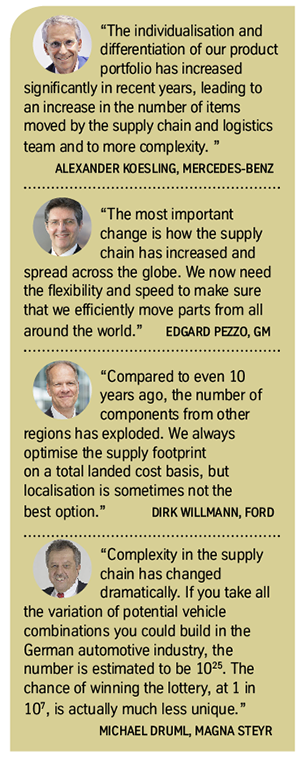 Even if General Motors has more recently retreated from several global regions, Edgard Pezzo agrees that the most notable development has been the international spread of the supply chain and the requirements that it puts on logistics management and services.
Even if General Motors has more recently retreated from several global regions, Edgard Pezzo agrees that the most notable development has been the international spread of the supply chain and the requirements that it puts on logistics management and services.
Another executive from a large, German-based tier supplier, who also requests anonymity, adds that OEM expansion to other markets has led tier suppliers to follow. Tier suppliers have also become larger, both through new plants and consolidation, which has made maintaining control in logistics more challenging.
But if global flows and parts variety have increased, the industry has also been able to make better use of tools at its disposal to manage them. Ford’s Joe Hinrichs cites the increase in data across the value chain as the most important development compared to the fledgling days of the internet in 1997.
Dana McBrien, at Honda North America, says the implementation of better IT systems has helped to make logistics operations even leaner than they were in the late 1990s.
Zernechel says Volkswagen Group has used IT to gain more control, including mostly recently via a cloud-based interface for shipping processes called Discovery.
Kevin Kinsey at Kia highlights the rise in electric ordering systems that allow for greater synchronisation of transport flows.
For Magna Steyr, Michael Druml describes an overall production and logistics system based more on data and information flow, including near universal connection between companies of all sizes by EDI, as opposed to only larger manufacturers or logistics providers.
He also says transport management is now more integrated compared to tracking by individual transport lanes. For example, when the company’s factory in Austria was producing Chrysler vehicles in the 1990s, he and his team chased two daily blocktrains of material from the ports of Hamburg and Rotterdam by calling individual train stations to find out if the train had passed yet or not.
In China, meanwhile, Ma Zengrong says the transformation has been even more radical. He maintains that carmakers in China had virtually no standardised approach to managing the supply chain in the 1990s, whether for packaging, parts handling, vehicle transport or IT.
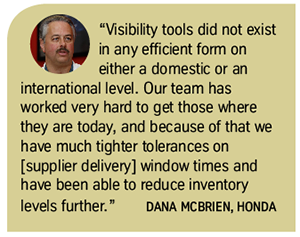 Today, after production and sales have risen more than twenty-fold, Ma thinks that system and supply chain integration is driving the industry forward. For example, today manufacturers in China organise their inbound logistics into milkruns and use consolidation processes similar to the west. For outbound, compared to almost no cars using rail just a decade ago, as many as 10% and rising – at least 3m vehicles per year – now move by train.
Today, after production and sales have risen more than twenty-fold, Ma thinks that system and supply chain integration is driving the industry forward. For example, today manufacturers in China organise their inbound logistics into milkruns and use consolidation processes similar to the west. For outbound, compared to almost no cars using rail just a decade ago, as many as 10% and rising – at least 3m vehicles per year – now move by train.
Following the growth of the supply chain, its challenges and its global links, executives also highlight the sector’s rising influence and importance across larger organisations.
What hasn’t changed as much as you would have expected?
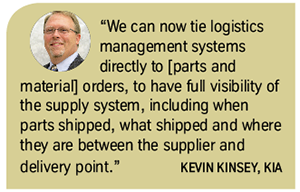 Even as systems are more dynamic, many promises of past decades remain unfulfilled. At GM, Edgard Pezzo admits that he expected the technology in use today would have allowed much greater visibility of logistics and materials than it currently does. At Magna, Druml recalls that RFID was meant to transform logistics in the 1990s – 20 years later, there is still more promise than implementation.
Even as systems are more dynamic, many promises of past decades remain unfulfilled. At GM, Edgard Pezzo admits that he expected the technology in use today would have allowed much greater visibility of logistics and materials than it currently does. At Magna, Druml recalls that RFID was meant to transform logistics in the 1990s – 20 years later, there is still more promise than implementation.
Meanwhile, companies are looking towards other technologies, such as telematics and sensors, to do what the industry has long desired. Mercedes-Benz’s Alexander Koesling acknowledges that the industry is still waiting for 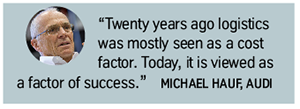 the price of certain technologies to fall.
the price of certain technologies to fall.
In China, Ma points to a supply chain that still lacks “operational intelligence”, and requires more open connectivity and collaboration. A source at a tier supplier, meanwhile, complains that the logistics industry in many countries still lacks paperless transport documents, even though UN conventions and EU laws allow them.
[mpu_ad]Others are surprised at how little has changed in physical technology and infrastructure. Audi’s Simon Motter says that when he was studying logistics at university 20 years ago, the expectation was that more areas of parts handling and warehousing would have been highly automated.
Digital simulations were also expected to play a major role in transport and warehouse management. While there have been advances in both areas – Audi has an automated small-load carrier warehouse at its plant in Ingolstadt, for example – for most of the past two decades, logistics automation has not played a major role.
Joe Hinrichs adds that most regions have the same transport assets and similar processes across a mostly unchanged logistics network. A tier supplier executive suggests that technical advances in transport equipment, such as ships, have lagged other areas, with high polluting heavy fuels and diesel the norm for many commercial vehicles.
 Honda’s Dana McBrien, however, has a different take on why technological and process change may be slow, at least for his company. He suggests that as manufacturing gets more complicated, inbound parts and line-side delivery will also evolve. However, it is important to preserve stability and avoid adding unnecessary processes wherever possible.An executive from a major premium carmaker looks to another area of disappointment: improvements in free trade under World Trade Organization rules. He suggests that in many regions, the barriers to trade remain high and volatile, with governments sometimes applying blockages from one day to another, for example in South American markets or Russia. With negotiations over Brexit and Nafta ongoing, further barriers to trade may well be erected.
Honda’s Dana McBrien, however, has a different take on why technological and process change may be slow, at least for his company. He suggests that as manufacturing gets more complicated, inbound parts and line-side delivery will also evolve. However, it is important to preserve stability and avoid adding unnecessary processes wherever possible.An executive from a major premium carmaker looks to another area of disappointment: improvements in free trade under World Trade Organization rules. He suggests that in many regions, the barriers to trade remain high and volatile, with governments sometimes applying blockages from one day to another, for example in South American markets or Russia. With negotiations over Brexit and Nafta ongoing, further barriers to trade may well be erected.
Have automotive logistics costs per vehicle risen, decreased or stayed the same?
Most executives agree that with longer supply chains, as well as more parts and technology in vehicles, higher labour and transport-related costs, the overall amount that manufacturers spend on logistics has increased in nominal terms.
That is the case according to the executive from one European premium carmaker. Honda’s Dana McBrien adds that more complex manufacturing and regulatory requirements have increased costs, while logistics-specific inputs like fuel and truck driver costs have increased. Kevin Kinsey at Kia attributes logistics’ rising share of vehicle costs to carrier premiums for drivers, at least in the US, as well as to higher levels of outsourcing for various aspects of manufacturing and service.
 While digital simulations have not played a significant role in logistics for the past 20 years, that now looks set to change
While digital simulations have not played a significant role in logistics for the past 20 years, that now looks set to changeAt Mercedes-Benz, Koesling sees rising costs in association with more outsourcing of manufacturing to suppliers, as well as increasing distances between suppliers and assembly plants. At Volkswagen Group, Zernechel agrees that transport distances have increased, as have labour and transport costs such as carriage rates and tolls.
However, executives also suggest that logistics costs have been compensated for by improved network engineering. At Volkswagen, consistent increases in fill and utilisation rates for packaging and transport have helped offset cost rises, as have efforts to combine freight across group brands.
At Ford, Willmann says the carmaker has worked with its lead logistics providers to constantly adjust and improve the freight network in both pre-series and series production. Edgard Pezzo also thinks that efficiency gains have helped to decrease costs relative to overall vehicle costs at GM.
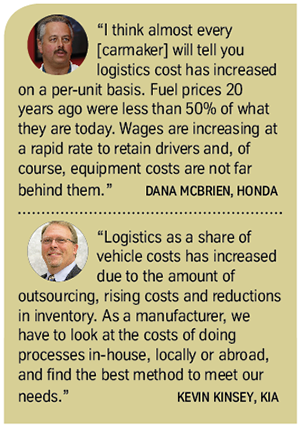 Decreasing the logistics cost per vehicle has been one of the main objectives for Mercedes-Benz after it reorganised its supply chain organisation several years ago. According to Koesling, success in this area has helped to improve overall profits. He points to increased standardisation for in-plant logistics, careful monitoring of logistics providers, supplier localisation, as well as continuous freight optimisation.
Decreasing the logistics cost per vehicle has been one of the main objectives for Mercedes-Benz after it reorganised its supply chain organisation several years ago. According to Koesling, success in this area has helped to improve overall profits. He points to increased standardisation for in-plant logistics, careful monitoring of logistics providers, supplier localisation, as well as continuous freight optimisation.
Some increases in logistics cost have also been to the benefit of overall purchasing and manufacturing costs. Kevin Kinsey says higher freight costs are the flipside of money saved on outsourcing labour, purchasing costs or reducing inventory.
Executives also point to more holistic approaches to purchasing, including a better total cost analysis than in the past – processes that helped identify where logistics may outweigh a saving elsewhere, or help the company’s overall bottom line. Both Mercedes-Benz’s Koesling and Volkswagen Group’s Zernechel say such approaches have led to increases in local parts sourcing where it makes the most sense.
In markets like China, meanwhile, the assessment of cost is complex. Spending on logistics has increased as carmakers expanded and volume exploded, however the addition of improved transport infrastructure and more advanced logistics systems have made the supply chain more efficient. 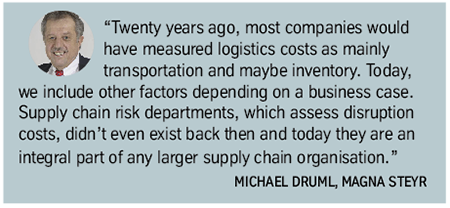 Meanwhile, stricter environmental and safety regulations are increasing costs, notably in China and India where restrictions on longer equipment and overloading have reduced available transport capacity.
Meanwhile, stricter environmental and safety regulations are increasing costs, notably in China and India where restrictions on longer equipment and overloading have reduced available transport capacity.
Ma also says that the value of logistics in relation to vehicle cost isn’t the best measure for China when comparing today’s sector with that of the late 1990s, when most of the cars purchased would have been considered luxury items.
Have order-to-delivery lead times for vehicles risen, decreased or stayed the same?
Order-to-delivery processes and lead times have also become more complex over the past 20 years. Increased localisation of plants and models in some regions has helped reduce lead time, while on the other hand the complexity of international supply chains both for parts and vehicles can make production and distribution stability harder to predict.
For some, the situation is straightforward. At one premium European carmaker, an executive maintains that overall lead times have increased, especially where model series are concentrated in one plant, which then exports finished vehicles or knockdown kits globally.
In markets like China, on the other hand, where 20 years ago production was less advanced, lead times have decreased, says Ma Zengrong. He points not only to more localised assembly, but the building of an almost entirely new infrastructure in many parts of the country, including a growing multimodal network with rail, coastal and barge shipping, which has helped cut logistics times.
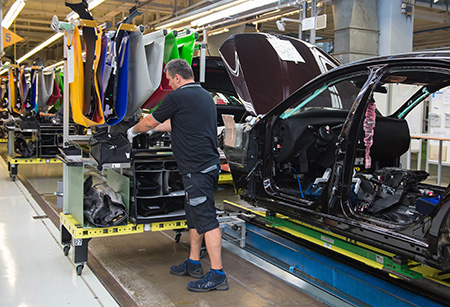 Parts variety, fuel and labour have increased the nominal costs of logistics, but OEMs have offset some of this rise with efficiencies
Parts variety, fuel and labour have increased the nominal costs of logistics, but OEMs have offset some of this rise with efficienciesManufacturers in the West recognise the demand from customers to decrease lead time and improve overall accuracy far beyond what is common today. Dana McBrien at Honda insists that carmakers must reckon with the ‘Amazon effect’, as customers increasingly expect fast, convenient delivery. With most customers doing the bulk of their vehicle research online, once they have narrowed their choices one of the decisive factors will be ‘who can deliver?’.
And yet, he admits that pressure for speed on the front end of the supply chain is complicated by expanding part numbers and inbound material lead time on the back end, with longer supplier distances and more international components. Kevin Kinsey recognises the same challenges for Kia.
At Audi, order-to-delivery times have been a major focus in the US and more recently China, where customers expect their  vehicles as soon as possible and are often unwilling to wait more than a few days for a vehicle before they choose another dealer or even brand. Michael Hauf says that over the past decade, Audi’s order-to-delivery time for the American market has decreased from an average of 120 days to around 60. One of the main reasons has been the introduction of pipeline trading for US dealers, who can now see the vehicles destined for the country, including those aboard incoming ro-ro ships, and select their orders much earlier. Audi has also recently introduced pipeline trading in China.
vehicles as soon as possible and are often unwilling to wait more than a few days for a vehicle before they choose another dealer or even brand. Michael Hauf says that over the past decade, Audi’s order-to-delivery time for the American market has decreased from an average of 120 days to around 60. One of the main reasons has been the introduction of pipeline trading for US dealers, who can now see the vehicles destined for the country, including those aboard incoming ro-ro ships, and select their orders much earlier. Audi has also recently introduced pipeline trading in China.
Hauf furthermore points to increased charters of ro-ro vessels for intercontinental trade directly by the Volkswagen Group logistics, which allows the group to have more visibility over shipping processes and thus to update delivery times at various time throughout the shipping cycle. With more control over this process, he thinks that Audi and other Volkswagen brands can gain more visibility and thus share information more readily with dealers.
 At Ford, global supply chains have also complicated the order-to-delivery process, including for vehicles supplied regionally. For example, in the ongoing transfer of production for the European market of the Ecosport compact SUV from Ford’s plant in Chennai, India, to Craiova, Romania, Dirk Willmann reveals that the inbound supply chain will include many components from India, China, Thailand and Brazil, requiring consolidation of supply in countries of origin.
At Ford, global supply chains have also complicated the order-to-delivery process, including for vehicles supplied regionally. For example, in the ongoing transfer of production for the European market of the Ecosport compact SUV from Ford’s plant in Chennai, India, to Craiova, Romania, Dirk Willmann reveals that the inbound supply chain will include many components from India, China, Thailand and Brazil, requiring consolidation of supply in countries of origin.
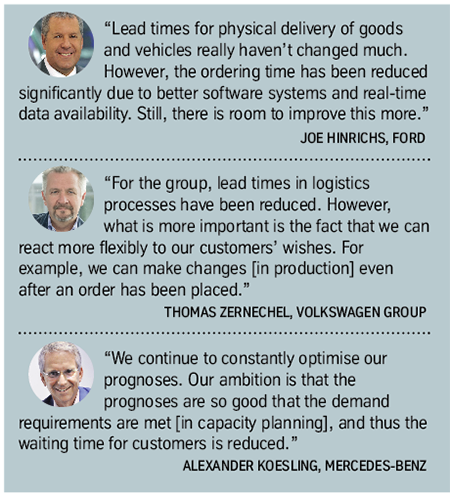 However, thanks to improvements made in Ford’s order and constraint systems and global management processes earlier this decade, Willmann says that it can much better coordinate capacity and supply across regions. Even if the final lead times for vehicles are not much shorter than in the past, Ford can better handle changes and more reliably deliver on promises.
However, thanks to improvements made in Ford’s order and constraint systems and global management processes earlier this decade, Willmann says that it can much better coordinate capacity and supply across regions. Even if the final lead times for vehicles are not much shorter than in the past, Ford can better handle changes and more reliably deliver on promises.
Volkswagen Group, Mercedes-Benz, GM and Honda all report lead time improvements, but most also point to similar focus on capacity management in improving the order process, and ultimately vehicle delivery. Zernechel says that the group’s switch to more frequent network steering, now done daily as opposed to weekly, helps it to adjust inbound supply in line with modifications in sales planning.
Koesling says that Mercedes-Benz has responded to customer requirements for shorter delivery times by running preventative programmes and capacity planning across its network, while also trying to improve forecasts.
What do you anticipate will be the most significant development for supply chain and logistics over the next decade?
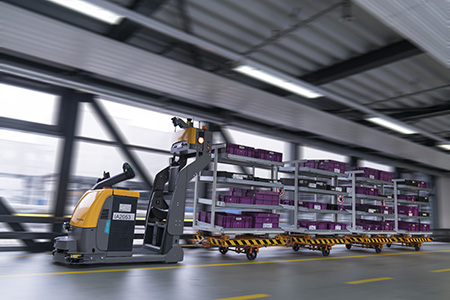 OEMs are incorporating more smart AGVs into their assembly plants
OEMs are incorporating more smart AGVs into their assembly plantsExecutives expect broader industry changes and technology specific to logistics will reshape future supply chains. The coming shift towards electric vehicle and alternative fuels is likely to have an impact, while autonomous driving, both for trucks in service but also for vehicle use and ownership, will lead to many process changes. For logistics, the push towards real time data, connectivity through the ‘internet of things’, and more advanced automation are expected to change both the physical and virtual management of logistics.
At Mercedes-Benz, Alexander Koesling anticipates that the complexity of electric vehicles, including the carmaker’s upcoming new EQ electric brand, will be one of the toughest challenges for supply chain management, including handling flows of new components and lithium-ion batteries. An executive at a German-based tier supplier also suggests that alternative-fuel vehicles will lead to significant changes in how vehicles are designed, produced and used by consumers, including new logistics requirements.
 Dana McBrien thinks transformation in mobility and electrification will drive supply chain change for Honda. Along with the products and processes this technology will require for logistics, he anticipates that a requirement from consumers for shorter lead times will lead to more small batch builds in plants, with logistics evolving to support that.
Dana McBrien thinks transformation in mobility and electrification will drive supply chain change for Honda. Along with the products and processes this technology will require for logistics, he anticipates that a requirement from consumers for shorter lead times will lead to more small batch builds in plants, with logistics evolving to support that.
At Audi, executives who noted the slow uptake of automation and digital simulation over the past 20 years now say the supply chain is digitalising beyond their expectations. Simon Motter points to the introduction of advanced driverless transport systems at Audi plants that are helping to transform highly manual processes like kitting. Audi’s new ‘supermarket 2.0’ approach for some processes in Ingolstadt, for example, now uses AGVs to bring shelves of parts to workers, who pick them using assistance systems such as pick-by-voice or pick-by-light.
 At Audi’s plant in Neckarsulm, meanwhile, there have been increases in automation in the supermarket for the Audi A8, with AGVs moving from kitting areas to automated lifts connecting to the assembly areas, where the AGVs transport parts to the line and retrieve empty containers.
At Audi’s plant in Neckarsulm, meanwhile, there have been increases in automation in the supermarket for the Audi A8, with AGVs moving from kitting areas to automated lifts connecting to the assembly areas, where the AGVs transport parts to the line and retrieve empty containers.
Meanwhile, if digital simulation of the supply chain had previously been limited, algorithm-based artificial intelligence and autonomous transport systems look set to drastically increase digital planning, execution and automation. Thomas Zernechel envisions “self-organising logistics systems”, including fully automated inventory management across warehouses and plants. Such systems will offer entirely new levels of efficiency, but also raise issues over IT infrastructure, as well as the ability of companies and employees to keep up.
Big data analytics, which will help companies not only capture data but interpret it and make advance decisions, are also expected to be increasingly essential to supply chain management.
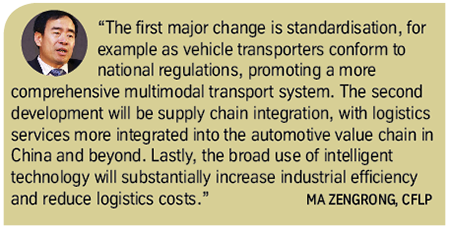 Michael Hauf thinks it is no longer far-fetched to suggest that individual parts, at least critical ones, would have their own IP addresses, allowing manufacturers to locate and validate them. He sees such a process as interesting not only for logistics, but also for meeting regulatory requirements for markets that require the use of certain parts, as this would help to show authorities a vehicle is compliant. Meanwhile, the use of in-vehicle telematics to track, locate and check the status of finished vehicles will allow significantly more visibility. Such developments are starting to happen today, Hauf says.
Michael Hauf thinks it is no longer far-fetched to suggest that individual parts, at least critical ones, would have their own IP addresses, allowing manufacturers to locate and validate them. He sees such a process as interesting not only for logistics, but also for meeting regulatory requirements for markets that require the use of certain parts, as this would help to show authorities a vehicle is compliant. Meanwhile, the use of in-vehicle telematics to track, locate and check the status of finished vehicles will allow significantly more visibility. Such developments are starting to happen today, Hauf says.
In markets in Asia, especially China, many similar challenges will also exist. However, CFLP’s Ma Zengrong still sees the next decade mostly as one in which China’s logistics and supply chain management will reach a higher level of standardisation and advanced logistics planning.
This article is one of a series of pieces celebrating Automotive Logistics’ 20th anniversary issue that together take an extended look at the way top executives feel automotive production and logistics have changed in the last two decades – and where they see them heading in the future.
The full series includes:
Production & logistics part 1: Where are we now?
Production & logistics part 2: Questioning the future
Production & logistics part 3: Operations, packaging and IT
Production & logistics part 4: Logistics organisations and skills
Topics
- Analysis
- Asia
- Audi
- Battery Supply Chain
- Brazil
- CFLP
- China
- Digitalisation
- Electric Vehicles
- Europe
- features
- Finished Vehicle Logistics
- Ford
- Ford
- GM
- GM
- Honda
- Inbound Logistics
- India
- Inventory management
- Kia
- Kia
- Magna Steyr
- Materials handling
- Mercedes-Benz
- Mexico
- North America
- OEMs
- Packaging
- Plant Logistics
- Policy and regulation
- Rail
- Road
- Romania
- Russian Federation
- Shipping
- South America
- Suppliers
- Supply Chain Planning
- Telematics
- Thailand
- Track-and-trace
- United Kingdom
- United States Of America
- VW
Production & logistics part 1: Where are we now?
- 1
- 2
 Currently reading
Currently readingProduction & logistics part 2: Questioning the future
- 3
- 4









